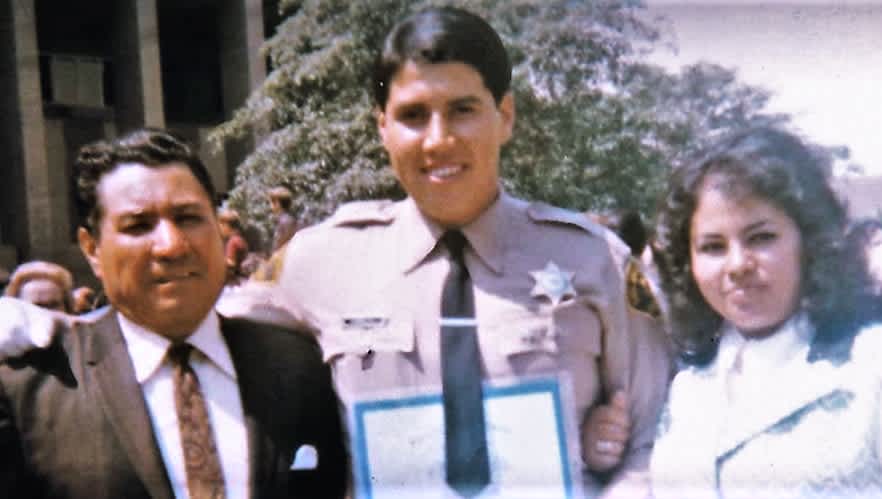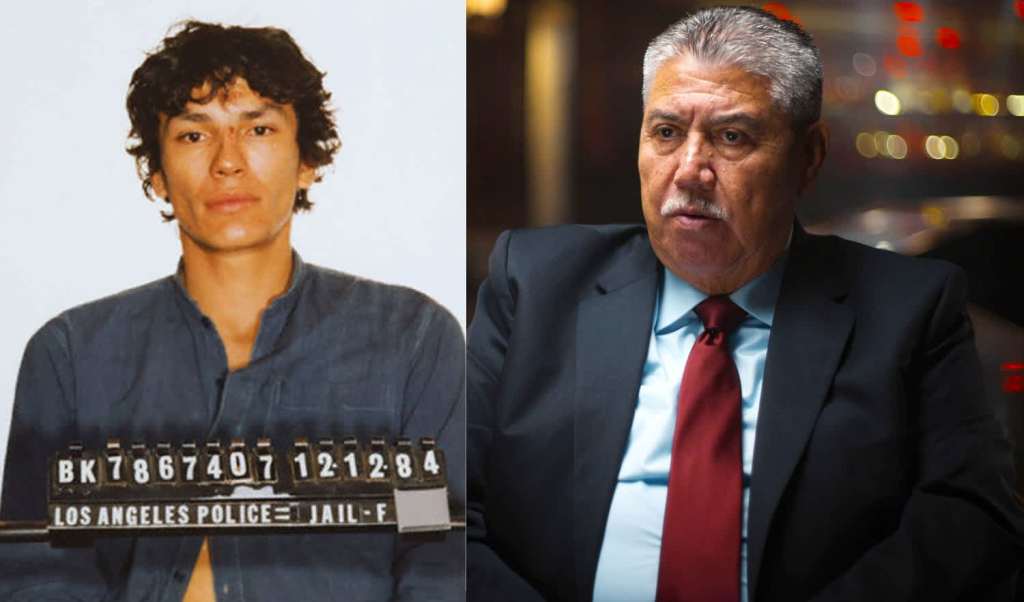Richard Ramirez. The Night Stalker. Say that name a few years go and you might have been met with a few puzzled looks. Say his name now and, thanks to the wildly popular Netflix series, you’ll be met with wide-eyed nods filled with knowing the horror of the man and his crimes.
Detective Gil Carrillo of the Los Angeles County Sheriff’s Department is now another name that is forever entwined with the brutal history of the Night Stalker. Carrillo was the young, upstart rookie partnered with a veteran of serial killer cases whose wild theories eventually brought Ramirez to justice.
The Latch spoke with Carrillo via Zoom from his sunny Los Angeles home to talk about his memories of the case and what it all means to be the man who put away the most horrific serial killer in American history.

“This is Part of My Life”
Anyone who has seen the four-part Netflix epic knows that it’s a shockingly brutal case. Ramirez was convicted of killing at least 13 people between the ages of nine and 83, as well as the attempted murder of five other people, 11 counts of sexual assault, and 14 counts of burglary. It is likely he attacked far more people for which he was never charged. The documentary suggests his victims could number as many as 30 or 40 additional.
It’s the type of stuff that sticks in your mind. “I’ll never forget it,” Carillo said. “But, it’s a lot easier living through it now than it was back then. He’s gone, he’s deceased, it’s all over.”
“Fortunately, I’m blessed with a decent memory. You remember the good but you remember the bad even more. This is etched in my mind but it’s not that bad.”
The story is a part of him, Carrillo understands, not something he can shy away or move on from. It’s why he’s now a household name and he accepts it for what it is. “This is part of my life. It’s part of history,” he tells us.
“You take away this case and I’m just another old, overweight, retired Hispanic cop. This case makes me somebody.”
Even so, having his work thrust into the global spotlight through the series was startling. While the media attention during the case was intense, it was also more localised. Netflix is global and Carrillo found himself inundated by messages from all over the world.
“I didn’t see it until it was released like everybody else. I had no idea! I had no way to anticipate the attention that it was going to draw. I’m not big on social media, I’m just simple-minded Gil,” he laughs. “It’s fascinating to me but it also validates that the work I did was all worthwhile.”
Just Doing His Job

People have always been intrigued by morbid stories, true crime drama, and a grisly or ghostly tale. While this trend has been the subject of much debate, Carrillo doesn’t really pay much attention to the why of it all. “I have no idea,” he said.
“Ramirez once asked me, ‘Why do you think I am the way I am? You know, what makes me do this?’ And my response to him was, ‘Richard, I’m a cop, I’m not a doctor. Let doctors tell why. I really don’t care. You did what you did and I do what I do.”
The worldview of Carrillo, the worldview of law enforcement, is, it seems, black and white. Crime equals punishment, no matter the circumstances that led up to the case. In spite of this linear thinking, Carrillo does understand that the violence of Ramirez’ upbringing made him into what he was.
“He did have an uncle that had been to Vietnam who used to talk about shooting people, showed him a lot of pictures of dead victims and death in Vietnam. And he allegedly shot his wife right in front of Richard. So he had taught him. This was embedded in him.
“As a kid, he was a victim of child abuse. He said his daddy used to beat him with a hose and in order to get away from his daddy he would go sleep in the local cemetery. I said, ‘Jesus, didn’t that frighten you being in the cemetery?’ ‘Oh no’, he says, ‘it was comfortable. It was a safe place for me’”.
“So he was just different. I don’t know what drove him to do what he did. But he was good at what he did.”
Hearing a police officer who worked so closely with the victims, saw all of the awful things Ramirez did, describe the man as “good at what he did” is somewhat jarring. Carrillo speaks almost in reverence of Ramirez, acknowledging the evil of his behaviour but also the infamy of it. For Carrillo, and for a lot of viewers, the interest in Ramirez is his prolific and unstoppable nature.
“I guess you have to look at it differently. To the homicide investigator, it’s not horrific at all. It’s very scientific. To a doctor who operates, when you see somebody with their abdomen wide open you may see blood, guts, and gore. That doctor doesn’t see that at all. He’s very scientific. The homicide scenes to us are scientific. So you don’t see the blood, guts, and gore, you look beyond that. Everything else is out of focus. Your focus is your job.”
While Carrillo spent long months on the case, trying to track down Ramirez, it was ultimately the public who brought him in. There’s an incredible scene at the end of the series where (spoilers) the people of LA recognise Ramirez, whose photograph has been published in all the newspapers, and chase him down, ultimately capturing him.
Carrillo tells us he was actually “split” on the capture, as he was hoping for either a quick arrest or for someone to kill him during an attack. Whatever it took to stop the bloodshed. But he was hoping to spend time with the Night Stalker to learn more about his behaviour, something he ultimately got.
“We really didn’t care who handcuffed him. We needed to stop this animal from what he was doing. But I also wanted to spend time with him and talk to him. I wanted to pick his brain, I want to learn from him. So very mixed emotions.”
Similarly, the fact that Ramirez died of natural causes at the age of 53 after spending a relatively short time in jail – in comparison to the time he was sentenced for and the overall length of the punishment one might expect for such crimes – didn’t really phase Carrillo.
“I did my job. Our job was to get him convicted and we saw through that conviction. The only person that stops suffering when he dies in there is him because the surviving victims, the family members, witnesses, or whoever else was involved in this case, they still have to live with that for life. The only thing death does is guarantees that he can’t hurt anybody else, either in prison or out of prison.”
Life After Death
After the case and the trial, Carrillo continued to work with the Los Angeles Sherriff’s Department Homicide Bureau for another 24 years until retiring in 2009. In his 38 year career, he investigated between 700 and 800 homicides and became Lieutenant Carrillo, the first Hispanic person to do so in the bureau.
Post-retirement, he’s travelled with his wife, Pearl, and lectured across the US on the case. Working on the Netflix series has “been the best part, for my family and my career,” Carrillo tells us.
“I have three children, 43, 46, and 49. They’re very much into the social media and they’re so excited. They’re hearing from friends that they went to kindergarten with. They’re just fascinated with all this attention.
“In my wildest imagination, I had no idea what the expectation was going to be at the end of this. Tiller Russell and company did a fabulous job putting it together. I was touched. I watched it and I cried and some of the things I saw on there. The attention that I’m getting, I mean, I’m talking to somebody from Australia right now! It just fascinates me that people are so interested in talking to Gil Carrillo.”
As is shown in the documentary, Carrillo’s true motivation in his work is the respect and admiration of his family. Not only his father, who Carrillo mentions often in the show, but his children and grandchildren too.
“It really made the career worthwhile. I told Mr. Russell, when he first approached me that I really didn’t care that much about television stuff like this. I did it to leave a legacy for my kids, and especially my grandkids. And I think this hit mark.
“There’ll be something for them to say that was my grandfather and that makes me happy. And the fact that it brought some happiness to people. So if we can reach out and make life different for one person, it’s good.”







